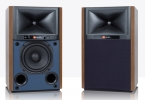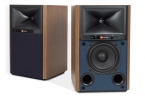JBL 4305P Powered Studio Monitor Review

Michael Evans listens to a new compact active wireless mini-monitor from a famous name…
JBL
4305P Powered Studio Monitor
AUD $3,999 RRP

Many domestic hi-fi loudspeaker buyers won't be aware of JBL's long and illustrious history in the audio industry. The company has often gone under the radar due to its speakers being associated mainly with recording studios, cinema sound and music festival PA systems.
The Los Angeles company dates back to the mid-nineteen forties and was founded on the back of the success of its sister company, Altec Lancing – by James Bullough Lancing, whose initials adorn their offerings. JBL's appeal has grown out of a cult following of owners who love the studio monitor sound coupled with its trademark horn treble units.
Despite JBL's parent company, Harman, now owned by tech giant Samsung Electronics, the latest 4305P looks distinctly retro and American with its wood veneer and aforementioned horns. Don't be deceived though, the South Korean influence ensures that this speaker packs a hefty chunk of twenty-first century technology.
The operative letter in its model name is 'P', which stands for powered; the 4305P is the company's first powered product in its consumer Studio Monitor range. The internal amplifier in the main speaker packs a claimed 300W RMS in total; that's 25W into each treble unit and 125W into each mid/bass driver. Times that by two (speakers), and you get JBL's quoted power output. It comes courtesy of a pair of Class D amplifiers, which is par for the course at this price point.

A 1-inch compression driver takes care of higher frequencies, which is mated to a 5.25-inch mid/bass driver sporting a fibre composite cone set within a cast metal frame. It's bolstered by twin bass reflex ports firing forward. Crossover frequency is 1.75kHz, slightly lower than you might expect for this sort of two-way speaker. This works together with a built-in 24-bit/192kHz DAC, which sports an optical digital input and a USB B in; there's no electrical coaxial digital input, sadly.
You will also find inputs for a quarter-inch jack and balanced XLRs (to remind us of the studio heritage, of course) plus a 3.5mm analogue auxiliary input. There's also an Ethernet socket to stream from your network and even a subwoofer output, in case you need a bit more lower-end oomph. The other input that some might miss is HDMI.
The 4305P also has a special connectivity party trick. Use a wireless connection between the master and slave speaker, and you get a maximum audio resolution of 96kHz. However, if you connect the two speakers via the supplied umbilical cord, the audio resolution extends to 192kHz, which delivers a noticeable sonic improvement. I suspect many listeners purchasing speakers at this price will want to extract maximum sound quality and will choose the wired connection. The good news here is that the connector is a standard cat5 ethernet cable, so nothing bespoke or expensive.

Google Chromecast is built-in, as is Apple AirPlay 2 and Bluetooth; MQA is accommodated too. My preferred source was a mobile device via USB B, utilising the USB Audio player pro app, or using the Bubble UPnP app to stream across my home network.
THE LISTENING
This speaker package has a distinctive sound quality, almost certainly due to the horn loading. I would say it is an acquired taste, as it can be a bit shouty in the top end; delicate souls need to be careful with their choice of music as bright recordings can be hard to listen to.
For example, Warriors of the Wasteland by Frankie Goes To Hollywood sounded too bright for my taste – even if it was very lively and dramatic. Switching to Welcome to the Pleasuredome – an earlier Trevor Horn production – was a different proposition and sounded much more palatable.

Bass is particularly good for a speaker system of this stature. Strong and deeper than you might expect, it really got a move on. Playing tracks with a strong bassline like Rush's Digital Man was a great case in point. Geddy Lee's Rickenbacker really thumped out! The same was true of Pulp Culture from Thomas Dolby; again, the bass line was a real treat and fast enough to keep up with the excellent transient speed of the tweeter.
However, this speaker can get a little confused on some tracks. Spirits in the Material World by The Police caused the treble to be a little harsh, and the bass too low. Whilst the bass response can be adjusted by 3dB via a switch at the rear, it was the top end that I felt needed taming!

THE VERDICT
If you like the JBL sound, then you'll probably love the 4305P. This small active streaming speaker system does much well, but not everything. It's lots of fun, but the problem is that it's bang-slap in the middle of a very crowded marketplace, with some very stiff competition. Packages like the Q Acoustics Active 200s are better all-rounders and cheaper too. Or you can buy a pair of non-networked active speakers like the Acoustic Energy AE1s and pair it with a quality DAC like Chord's Mojo 2. You pays your money, and takes your choice…
For more information visit JBL
Michael Evans
A music junkie who served his apprenticeship in UK hi-fi retail in the 1990s, Mike loves the simplicity of analogue and the complexity of digital. With an encyclopaedic knowledge of the subject, he’s been on a life-long quest for great sound at a sensible price – and is still loving the journey…
Posted in:Hi-Fi Loudspeakers Active Bookshelf / Standmount
Tags: jbl harman convoy
JOIN IN THE DISCUSSION
Want to share your opinion or get advice from other enthusiasts? Then head into the Message Forums where thousands of other enthusiasts are communicating on a daily basis.
CLICK HERE FOR FREE MEMBERSHIP
Trending
applause awards
Each time StereoNET reviews a product, it is considered for an Applause Award. Winning one marks it out as a design of great quality and distinction – a special product in its class, on the grounds of either performance, value for money, or usually both.
Applause Awards are personally issued by StereoNET’s global Editor-in-Chief, David Price – who has over three decades of experience reviewing hi-fi products at the highest level – after consulting with our senior editorial team. They are not automatically given with all reviews, nor can manufacturers purchase them.
The StereoNET editorial team includes some of the world’s most experienced and respected hi-fi journalists with a vast wealth of knowledge. Some have edited popular English language hi-fi magazines, and others have been senior contributors to famous audio journals stretching back to the late 1970s. And we also employ professional IT and home theatre specialists who work at the cutting edge of today’s technology.
We believe that no other online hi-fi and home cinema resource offers such expert knowledge, so when StereoNET gives an Applause Award, it is a trustworthy hallmark of quality. Receiving such an award is the prerequisite to becoming eligible for our annual Product of the Year awards, awarded only to the finest designs in their respective categories. Buyers of hi-fi, home cinema, and headphones can be sure that a StereoNET Applause Award winner is worthy of your most serious attention.











